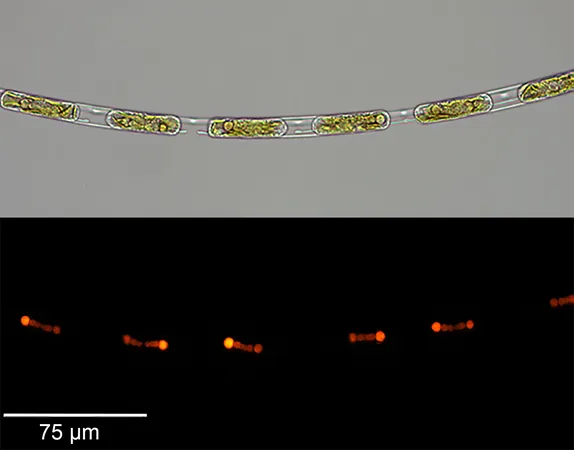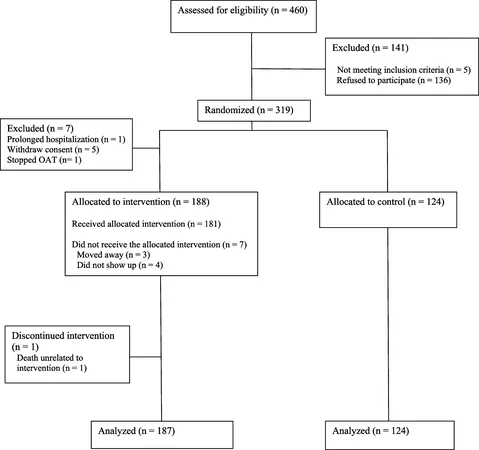
Unlocking Evolution: The Remarkable Partnership Between Algae and Bacteria
2025-08-29
Author: Arjun
A Microscopic Alliance in Our Oceans
In the depths of our ocean's nutrient-poor waters, an extraordinary partnership is thriving: a microscopic alliance between algae and bacteria. Recent groundbreaking research from Stockholm University, in collaboration with the Swedish University of Agricultural Sciences and Linnaeus University, has unveiled how these tiny organisms evolve and adapt through gene loss and increasing dependence on one another.
The Symbiotic Duo: Diatoms and Cyanobacteria
At the heart of this relationship are diatoms—microscopic algae that are masters of photosynthesis—and cyanobacteria from the genus Richelia, which expertly convert nitrogen from the air into a usable form for their diatom hosts. In this symbiotic dance, diatoms utilize sunlight to transform carbon dioxide into vital energy, reinforcing life in some of the ocean's harshest environments.
Evolutionary Stages: A Fascinating Continuum
The interaction between Richelia and diatoms varies dramatically. Some cyanobacteria cling to the surface of their hosts, while others dwell in the spaces between the diatom's cell layers, and still more completely inhabit the diatom's cells. This "continuum" of integration provides researchers with a snapshot into the evolutionary journey of these partnerships at various stages.
As symbionts grow increasingly dependent on their hosts, they tend to lose certain genes. Professor Rachel Foster from Stockholm University explains, "As symbionts become more integrated, they start losing genomic information that overlaps with their hosts. This offers us an exciting opportunity to study the evolutionary process in real time."
Uncovering Genomic Secrets
Dr. Vesna Grujcic, a postdoctoral researcher, utilized a comparative genomics approach to unveil how specific genomic traits of Richelia change as they become more reliant on their hosts. "We can identify which genes disappear and which remain, providing a rare glimpse into the step-by-step evolution of these partnerships," she reveals.
A Living Laboratory of Evolution
This research highlights that multiple stages of symbiotic integration coexist, allowing scientists like Daniel Lundin from Linnaeus University to delve deep into the genetics behind the evolution of these relationships. Grujcic's pangenome analysis revealed both core genes shared across Richelia and unique accessory genes that vary among species, adding depth to our understanding of their evolutionary trajectories.
Jumping Genes: A Twist in the Tale
The team also discovered intriguing information about 'jumping genes' or transposons—DNA fragments that can move within the genome. While studying a symbiont lodged between the diatom's cell walls, they found that it maintained a surprisingly large genome despite the absence of certain metabolic functions. This led to a revelation about how the genome's size could be inflated due to the abundance of insertion sequences.
A New Model for Symbiotic Evolution
The symbiotic relationship between diatoms and Richelia presents researchers with an unparalleled model to study evolutionary processes in real-time. As one of the few documented examples of symbiosis in transitional phases, this partnership not only enriches our understanding of evolutionary dynamics but also places it alongside other significant symbiotic studies.



 Brasil (PT)
Brasil (PT)
 Canada (EN)
Canada (EN)
 Chile (ES)
Chile (ES)
 Česko (CS)
Česko (CS)
 대한민국 (KO)
대한민국 (KO)
 España (ES)
España (ES)
 France (FR)
France (FR)
 Hong Kong (EN)
Hong Kong (EN)
 Italia (IT)
Italia (IT)
 日本 (JA)
日本 (JA)
 Magyarország (HU)
Magyarország (HU)
 Norge (NO)
Norge (NO)
 Polska (PL)
Polska (PL)
 Schweiz (DE)
Schweiz (DE)
 Singapore (EN)
Singapore (EN)
 Sverige (SV)
Sverige (SV)
 Suomi (FI)
Suomi (FI)
 Türkiye (TR)
Türkiye (TR)
 الإمارات العربية المتحدة (AR)
الإمارات العربية المتحدة (AR)